
Browse an alphabetical list of photographs. These historical images portray people, places, and events before, during, and after World War II and the Holocaust.
<< Previous | Displaying results 951-1000 of 2641 for "Photo" | Next >>
Prisoners at forced labor in the brick factory at Neuengamme concentration camp. Germany, date uncertain.
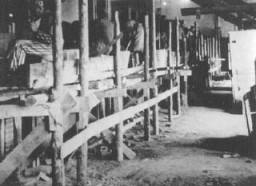
Women prisoners pull dumpcars filled with stones in the camp quarry. Plaszow camp, Poland, 1944.
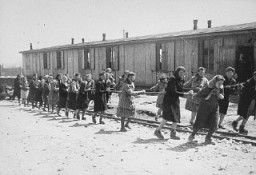
Prisoners at forced labor in the Neuengamme concentration camp, Germany, 1941-1942.
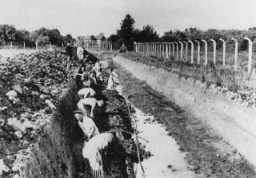
A Jewish man deported from Vienna, Austria, performs forced labor in the Opole Lubelskie ghetto. Poland, date uncertain.

Prisoners at forced labor under SS and police guard in the Oranienburg concentration camp. Oranienburg was one of the first first concentration camps established in Germany. Oranienburg, Germany, 1934.
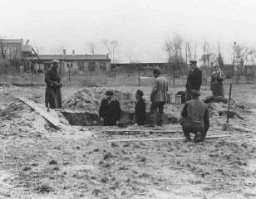
Inmates at forced labor in the Ravensbrück concentration camp. Germany, between 1940 and 1942.

Romani (Gypsy) inmates stand at attention during an inspection of the weaving mill, site of forced labor in the Ravensbrück concentration camp. In this workshop prisoners wove reed mats used to reinforce roads in swampy regions of the eastern front. Germany, between 1941 and 1944. This photograph is from an SS propaganda album.
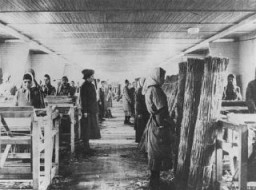
Prisoners at forced labor in the Siemens factory. Auschwitz camp, Poland, 1940–44.
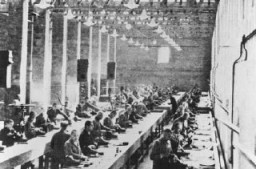
As a German soldier looks on, Tunisian Jews are forced to sweep the street and move a wooden crate on a hand cart. Tunisia, 1942-43. Photograph courtesy of Bundesarchiv, German Federal Archives
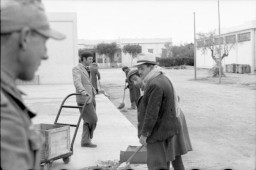
Jewish women sort confiscated clothing in the Lodz ghetto. Photograph taken by Mendel Grossman between 1941 and 1944. Mendel Grossman photograph collection
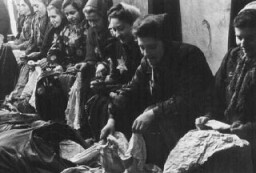
Forced laborers build the south wall of the foundation of the new Dachau satellite camp of Weingut I in Mühldorf . Germany, 1944.
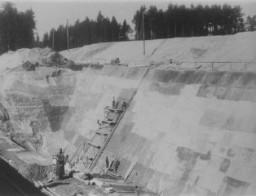
With bowls in hand, conscripts of a Jewish Hungarian labor unit wait for food. Abony, Hungary, 1940.
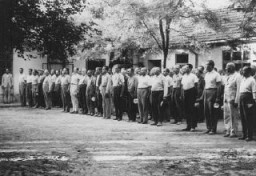
Forced-labor camp for Roma (Gypsies). Lety, Czechoslovakia, wartime.

Fleeing the advance of the Soviet army, the Germans forcibly evacuated westward by barge these prisoners of the Stutthof concentration camp. Near Danzig, January 1945.
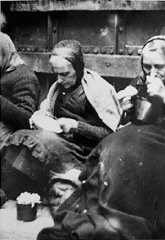
Jewish homes in flames after the Nazis set residential buildings on fire in an effort to force Jews out of hiding during the Warsaw ghetto uprising. Poland, April 19–May 16, 1943.
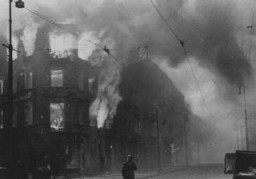
Foreign Jews arrested in Paris at the Austerlitz train station before deportation to the French-administered internment camps Pithiviers and Beaune-la-Rolande in the Loire region. Paris, France, ca. May 1941.
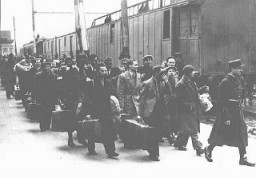
A group of foreign-born Jews poses for a photo in Gurs, a French internment camp in southwestern France. Gurs, France, 1941. Samuel Liebermensch is pictured at the center. Hugo Mayer is seated on the lower right. Siegfried Lindheimer is pictured in the first row , second from the left.
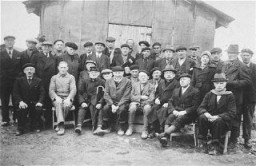
Judge Thomas Buergenthal, formal portrait for the International Court of Justice in the Hague. ca. 2003.
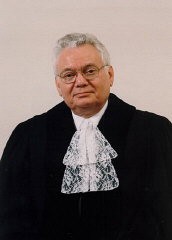
Postwar photograph of gas chamber for mass murder in the Auschwitz main camp. Poland, ca. 1947. In mid-August 1940, Auschwitz concentration camp authorities put into operation a crematorium adjacent to a morgue. This building was located just outside the boundaries of the Auschwitz main camp. In September 1941, the morgue was converted to a gas chamber for mass murder where several hundred people could be killed at a time. This gas chamber was used until December 1942, though the crematorium remained…
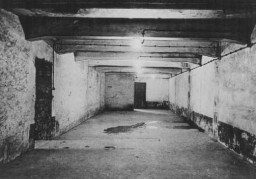
Former prisoners of the "little camp" in Buchenwald stare out from the wooden bunks in which they slept three to a "bed." Elie Wiesel is pictured in the second row of bunks, seventh from the left, next to the vertical beam. Abraham Hipler is pictured in the second row, fourth from the left. The man on the third bunk from the bottom, third from the left, is Ignacz (Isaac) Berkovicz. [He has also been identified as Abraham Baruch.] Michael Nikolas Gruner, originally from Hungary, is pictured on the bottom…
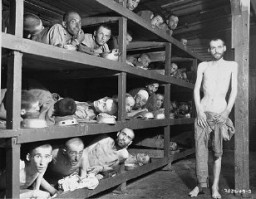
American military police admit a father and daughter, both displaced persons, to the refugee shelter at Fort Ontario. Oswego, New York, United States, after August 4, 1944.
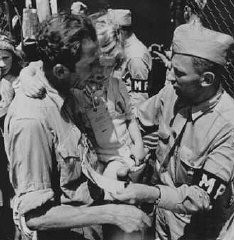
Secretary of Labor Frances Perkins testifies before the House Committee on migrant workers. Washington D.C., December 1940.

Holocaust survivor Frank Liebermann has a conversation with his teddy bear. Germany, 1933–35. On Frank Liebermann’s first day of school in Gleiwitz, Germany, in 1935, he reported to one of the few small classrooms set aside for Jews. After school, he rushed home to avoid antisemitic attacks. In 1936, it got worse. Anti-Jewish laws now banned Frank from playgrounds and swimming pools. The family decided it was time to leave and applied for US visas. They were lucky. In October 1938, the…
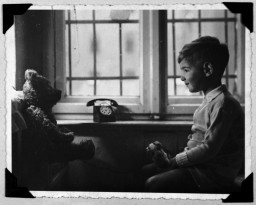
President Franklin D. Roosevelt sits with Eleanor Roosevelt in his study in the White House. FDR was elected the 32nd president of the United States in the presidential elections of November 1932. Washington, DC, 1933.
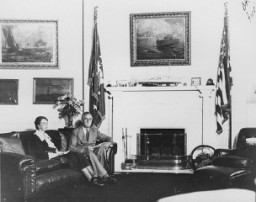
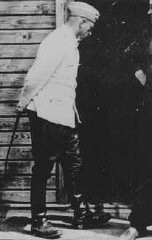
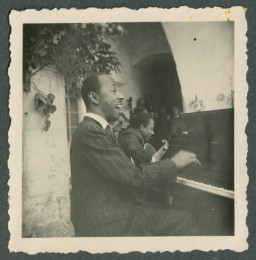
(1941-1942) Crowded newsstands in the United States such as these held journals representing various political parties and ideologies. Americans had access to many different perspectives about what was happening at home and abroad during the war.
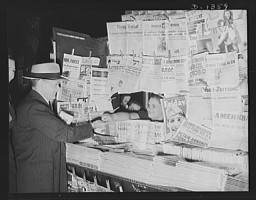
A French army ambulance during World War I. This photograph was taken ca. 1914–1915.
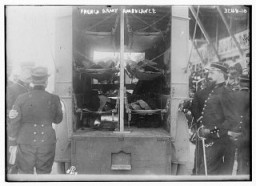
French General Charles de Gaulle and resistance leader Georges Bidault confer before marching down the Champs-Elysees to Notre Dame in ceremonies marking the liberation of the French capital. Paris, France, August 1944.
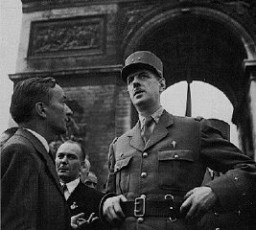
French government announcement concerning antisemitic legislation. Paris, France, December 10, 1941.
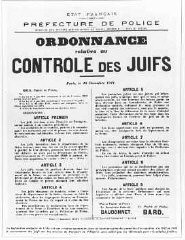
French leader Charles de Gaulle in London after France signed an armistice with Germany on June 22, 1940. De Gaulle refused to accept the armistice and led the Free France resistance movement. London, Great Britain, June 25, 1940.
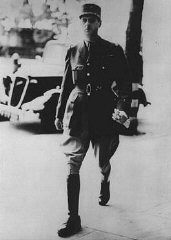
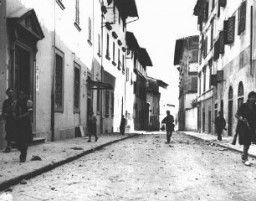
French police check the identity cards of pedestrians during the roundup of Jews on the Boulevard Voltaire (near the Place de la Republique) in Paris, France, August 20, 1941.
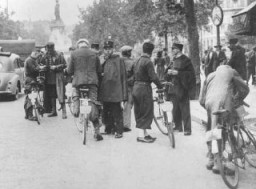
Like many editions of the Protocols of the Elders of Zion published in the 1920s, this French-language version charges that Jews are a foreign and dangerous influence. Published in Paris, 1920.
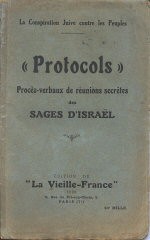
“For three months I was disguised as a man, and very successfully… I passed my mother several times … she never recognized me.” Frieda Belinfante, a half-Jewish lesbian, used this disguise to hide from Nazi authorities. In a later interview she said, “I really looked pretty good.” Her involvement in the resistance movement included planning the destruction of the Amsterdam Population Registry in March 1943, falsifying identity cards, and arranging hiding places for those who were sought by…
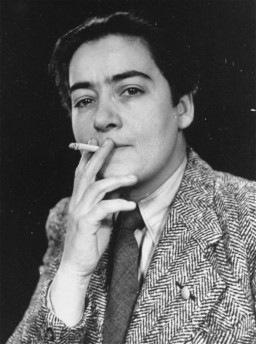
A hand-tinted photograph of Frieda Greinegger and Julian Noga as a young couple. The two had met when Julian, a forced laborer from Poland, arrived at the Greinegger farm in northern Austria. In 1941, the Gestapo sent both to concentration camps after learning of their forbidden friendship. Place uncertain, after 1945.
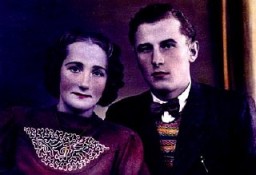
Friedrich Mennecke, a Euthanasia Program physician who was responsible for sending many patients to be gassed. He was sentenced to death in 1946. Germany, date uncertain.
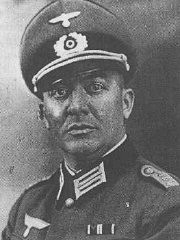
Fritz and Ida Lang, Jewish proprietors of a dry goods store in Lambsheim, posed for this picture around 1934. In the early 1940s, Nazi authorities deported the Langs and their young daughter, Freya, to detention camps in France. Ida died after deportation to Auschwitz. Fritz survived and reunited with his daughter in 1946. Lambsheim, Germany, ca. 1934.
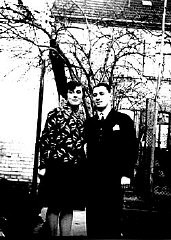
Fritz Glueckstein (left) on a picnic with his family in Berlin, Germany, 1932. Fritz's father was Jewish—he attended services in a liberal synagogue—and his mother was Christian. Under the Nuremberg Laws of 1935, Fritz would be classified as mixed-raced (Mischling), but since his father was a member of the Jewish religious community, Fritz was classified as a Jew.
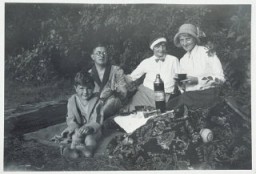
Fritz Kuhn, head of the antisemitic and pro-Nazi German American Bund, speaks at a rally. United States, between 1936 and 1939.
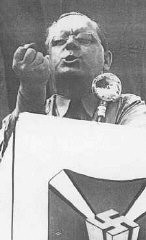
Front page of the most popular issue ever of the Nazi publication, Der Stürmer, with a reprint of a medieval depiction of a purported ritual murder committed by Jews.
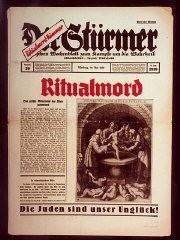
In February 1929, the Nazi newspaper "Der Stuermer" depicted a caricature of Magnus Hirschfeld. The Nazi Party attacked Dr. Hirschfeld for his ideas about sex, sexuality, and gender, as well as his Jewish ancestry.
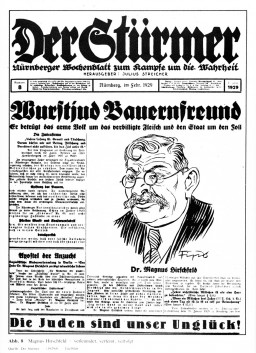
SS officer Karl Höcker salutes in front of an array of wreaths during a military funeral near Auschwitz. The original caption for the photograph reads "Beisetzung von SS Kameraden nach einem Terrorangriff." (Burying our SS comrades from a terror attack.) Pictured in the background are Josef Kramer and Karl Moeckel.This image shows the aftermath of the September 13, 1944, bombing of IG Farben in which 15 SS men died in the SS residential blocks and 28 were seriously wounded.
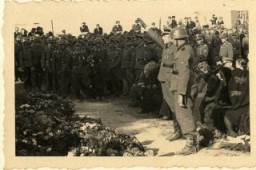
After the liberation of the Wöbbelin camp, US troops forced the townspeople of Ludwigslust to bury the bodies of prisoners killed in the camp. This photo shows US troops assembled at the mass funeral in Ludwigslust. Germany, May 7, 1945.

After the liberation of the Wöbbelin camp, US troops forced the townspeople of Ludwigslust to bury the bodies of prisoners killed in the camp and give the victims a proper burial. This photograph shows the funeral for the victims. Germany, May 7, 1945.
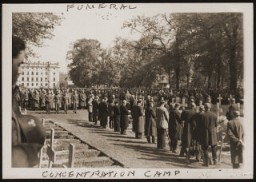
Scene during the funeral of SS officers killed in the December 26, 1944, Allied bombing of Auschwitz.
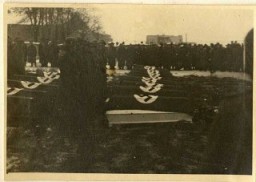
Funeral procession for victims of the Kielce pogrom. Kielce, Poland, July 1946.
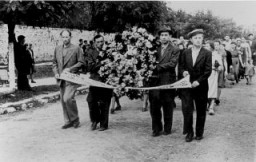
US troops and German civilians from Neunburg vorm Wald attend a funeral service for Polish, Hungarian, and Russian Jews found in the forest near their town. The victims were shot by the SS while on a death march from Flossenbürg. Neunburg, Germany, April 29, 1945. Following the discovery of death march victims, US Army officers forced local Germans to view the scene of the crime and ordered the townspeople to give the victims a proper burial.
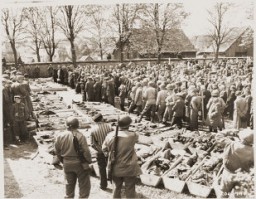
After the liberation of the Wöbbelin camp, US troops forced the townspeople of Ludwigslust to bury the bodies of prisoners killed in the camp. This photograph shows American troops at the funeral service for the victims. Germany, May 7, 1945.
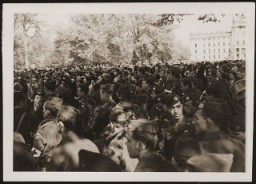
This identity card was issued to Henryk Lanceter at the Fürth Displaced Persons Camp in Germany.
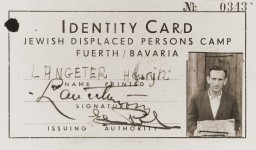
We would like to thank Crown Family Philanthropies, Abe and Ida Cooper Foundation, the Claims Conference, EVZ, and BMF for supporting the ongoing work to create content and resources for the Holocaust Encyclopedia. View the list of donor acknowledgement.